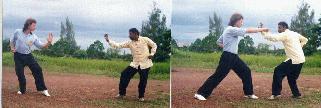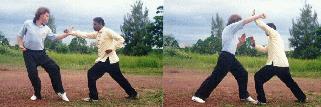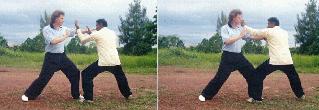SELECTION OF QUESTIONS AND ANSWERS
SEPTEMBER 1998 PART 2

Jack and Mogan in combat poises. Jack moves in with a thrust punch, known in Shaolin Kungfu as “Black Tiger Steals Heart”. Mogan responds with “Single Tiger Emerges from Cave”. (To be continued below)
Question 1
I've been interested in the role of mind in kungfu, especially meditative aspects.
— Hua, USA
Answer
While many other martial arts are mainly concerned only with combat, mind is the most important aspect in great kungfu like Shaolin and Taijiquan. That is why in some kungfu stories or movies, it is depicted that the master advises his best students to train with the mind, which is usually termed as “heart” in the Chinese language.
Question 2
My Taiji teacher said that there was a kind of meditation practiced by Confucian scholars to enhance mental acuity.
Answer
Yes. The famous Confucian master, Zhu Xi, advised that one should spend half the day in meditation and the other half in study. All meditation, Confucian and non-Confucian, enhances mental acuity. Meditation is the training of mind.
Question 3
Moreover, from the limited knowledge I have of Zen, the meditation practiced enables the Zen master to find the solutions to problems that others may deem impossible. (I must emphasize that my knowledge is limited.) Can you provide some insight on these issues?
Answer
Not only Zen, but all meditation enables the meditator find solutions that others deem impossible. All the great creations or discoveries in arts, science, philosophy and religion were made when the artists, scientists, philosophers and religious teachers were in a meditative state of mind distinctly differently from everyday consciousness.
This was because in their meditation, they tapped into universal consciousness. Great artists, scientists, philosophers and religious teachers, like Michelangelo, Edison, Plato and Mohammed, explicitly said that their findings came from the cosmos, called God by some peoples.
Question 4
Does Taiji or other martial arts enhance one's mental functioning? In your book on Taiji you mention “mental freshness”; does this lead to enhanced intelligence?
Answer
I often use the term “Taiji” or “Tai Chi” to refer to the external, dancelike movement of Taijiquan, and the term “Taijiquan” for the real art which focuses on energy and mind. Taiji dance and external martial arts may enhance one's mental functioning minimally, but in many external martial arts sometimes a practitioner's mental functioning may be impaired through constant hits on his head that are routinely left unattended to.
But in great kungfu like Taijiquan and Shaolin, enhancing one's mental functioning is direct and purposeful. Hence the result of mental enhancement in genuine Taijiquan and genuine Shaolin Kungfu is tremendous. If you recall that training of mind is an essential dimension in Taijiquan and Shaolin Kungfu, you will better appreciate why a Taijiquan or Shaolin disciple will enhance his mental functioning.
There are many ways mind training is accomplished in Taijiquan and Shaolin Kungfu. For example, in Taijiquan, every movement is directed by mind. In Shaolin Kungfu, a disciple is trained to focus his mind at a particular spot on his opponent so that a strike can “automatically” land there. This explains why a dim mark master can accurately “dot” an opponent's vital spot even amidst much movement and even the spot is tiny. When the mind is trained, logically mental functioning is enhanced.
Yes, mental freshness leads to enhanced intelligence. We are not particularly keen to know whether a “scientific” measurement or test of his intelligence quota will actually show an increase, but we know from practical experience that one whose mind has been trained through genuine Taijiquan or Shaolin Kungfu has better results than before his training in problem solving, academic studies, seeing relationship, understanding complicated information and other mental activities.

Mogan counter-attacks with “Black Tiger Steals Heart”, to which Jack responds with “Single Tiger Emerges from Cave. Immediately Jack moves forward with ”Hang a Golden Star“ at Mogan's left temple. Mogan defends with ”Immortal Emerges from Cave". (To be continued below)
Question 5
The style is called Yu-chia and it is rich in practical striking, blocking, joint locking and grappling techniques and has a number of short and fast sets. Donn Draeger and Robert W. Smith, in Asian Fighting Arts (1969), briefly list Yu-chia as a hard-soft style of Shaolin from the Honan province school. Any further information you may have on this style would be very much appreciated.
— Michael, USA
Answer
The term “Yu-chia” means “Yu family”. Yu-chia Kungfu could be initiated by Yu Da You, a great general of the Ming dynasty, or it was inspired by him. The modern kungfu master, Wan Lai Sheng (who should be over 80 years old now if he is still alive in China), is a Yu-chia Shaolin Kungfu expert.
Yu-chia Kungfu is a Northern Shaolin style, and is suitable for people of small physique, but is not disadvantageous to the big and strong. It is rich in techniques and covers all the four categories of attack, namely hitting, kicking, felling and gripping. It also has a wide variety of weapons, and is formidable in its spear techniques.
It does not depend much on mechanical strength, but emphasizes internal force. One remarkable method of Yu-chia internal force training is called “Lifting Water Barrel”. Basically, the method is as follows. Get a bundle of 10 to 20 chop sticks. “Sit” on a horse-riding stance, and gently focus your chi at your abdominal dan tian (energy field).
Hold the bundle in front with both hands at mouth level, as if blowing a trumpet. One hand holds the front end of the bundle, and the other hand holds the back end, and the bundle points forward. While gripping the chop sticks, turn the front hand clockwise, and the back hand (which is in front of the mouth) anti-clockwise, then reverse. Repeat for about five minutes. Gradually increase the time to about half an hour or more. Take care not to raise your horse-stance.
When you can perform the above routine fairly well, hang an empty barrel tied to a rope on the bundle of chop sticks, and practice like before. Gradually add water into the barrel. (A pail can be used instead of a barrel.) If you just practice this “Lifting Water Barrel” daily for a year, you can develop remarkable internal force. It may be hard for the uninitiated to believe, but not only your grips and strikes are powerful, and your stance solid and stable, you can also take punches and kicks without sustaining injury. (Of course, here we are referring to ordinary attackers; if a master with powerful internal force strikes you, he can cause damage.)
Give this apparently simple method a try, and in three months your friends and you yourself will be surprised at the effect. But pay attention to the following “don'ts”. Do NOT use strength in your hand-turning! Do not be tensed. Do not strain yourself or over-train. If you feel pain or tightness at your chest, stop your practice for a few days. Resume training only when the pain has disappeared.
Question 6
You mentioned in one of your answers that Chi Kung SHOULD be practice after sex.
— Dudley, UK
Answer
What I mean is that practicing certain types of chi kung after sex is advisable. I do not mean one must (without fail) practice chi kung after sex.
Question 7
I have read many times that after normal intercourse during which a man ejaculates, he SHOULD NOT practice chi kung for a day.
Answer
This is a common advice of chi kung masters. It specially applies to hard chi kung. Training hard chi kung (or martial art chi kung) where force is often exerted, after sex may drain the practitioner. But leisurely practice gentle chi kung, like self-manifested chi movement, after sex can be beneficial.
Question 8
Is it that he should only avoid certain kinds of chi kung? For instance, should he avoid concentrating energy in his dan tian and instead perform energy gathering and regulating exercises like Lifting the Sky?
Answer
Yes, your observation is excellent.
Question 9
The primary justification I have read for discontinuing chi kung after normal intercourse in which a man ejaculates is that it can put too much strain on your chi system. Why do you suggest chi kung after sex?
Answer
Your justification is correct. There are many kinds of chi kung, as well as many different approaches even when practicing the same kinds.
While practicing hard chi kung after sex is generally harmful, it may not be so for a master.
I suggest chi kung after sex because it can replenish the energy lost during the sex act. For a person who feels fatigued after the act, appropriate chi kung practice can revitalize him.

From the previous position shown in the photograph above, Jack thrusts a frontal palm strike at Mogan's throat, in a pattern known as “White Snake Shoots Venom”. Mogan shifts to a sideway Horse-riding Stance and intercepts the palm strike with “Intercept Big Boss”. Immediately Mogan executes a horizontal palm strike at Jack's neck. (To be continued below)
Question 10
Is it OK to practice just the second part of the “Art of Wisdom” on page 129, starting from step no 8 -- visualizing the downward and upward flow of Chi thru the body and the “Oneness with Cosmo” method?
— Jo, USA
Answer
It is alright, but you will get better result if you practice both parts — even practicing the first part for a few seconds.
Take an analogy from long jump. You may jump from the spring board, but you will get better result if you run up to the board before you jump.
Question 11
In the Bow-arrow stance and the False Leg stance, is the front leg/foot directly in front of the back leg/foot, or is the front leg/foot off to the side a little? Also, are the feet straight or at an angle in these stances?
— Kelvin, USA
Answer
The front foot is generally in front of the back foot, but sometimes for some good reasons it may be placed off to a side. Similarly, the feet are straight but sometimes they can be at an angle.
Question 12
In general, do you suggest any type of warming up before beginning stance training?
Answer
“Lifting the Sky” and leg stretching are good “warming up” exercises, though they are not essential.
Question 13
What are your thoughts on strength training such as push-ups, pull-ups, and lifting weights to build strength? Do you feel these are good or bad for kung fu training.
Answer
These physical exercises are good, but chi kung exercises are better.
Even when you have chi kung exercises, the physical exercises can often be employed as supplements.
However, from the kungfu perspective, they are bad if they are used to build muscles, in which case the strength will be “locked”.
Question 14
If you feel these are not good for kung fu training, are there any types of strength training that is beneficial for enhancing kung fu skills?
Answer
There are many.
The following are just a few random examples: Golden Bridge and Pushing Mountains in Shaolin Kungfu; Three Circles Stance and Lifting Water in Taijiquan; Iron-Wire Set in Hoong Ka Kungfu; Lohan Art in Praying Mantis Kungfu; and Gripping Jars in Eagle Claw Kungfu.
Those used to physical exercises may find it hard to believe, but these kungfu force training methods produce much more power than push-ups, pull-ups and lifting weights. Moreover, they are not limited by size or age.

Jack defends against Mogan palm strike by intercepting Mogan's movement at Mogan's elbow. Instantly Jack jabs a left leopard fist at Mogan's ribs. (To be continued below)
Question 15
Do you recommend any type of aerobic exercise to enhance kung fu training, such as walking, running, etc.?
Answer
No. In fact, anyone recommending such physical exercises is a clear indication that he knows little about force training in kungfu.
These physical exercises train only muscles, and even that the improvement is minimal compared to what can be achieved in kungfu training. Any improvement in stamina, endurance, flexibility, agility, balance, fluidity, speed and other qualities valued for combat or daily peaceful living is attained through walking, running and other aerobic exercises indirectly, not purposefully.
Kungfu training is directed and purposeful. When kungfu masters want to develop a certain ability, they find out the root-requirements for that ability, and work on them. For example, to have good stamina, one requires a smooth intake of cosmic energy and an adequate disposal of toxic waste, an appropriate storage space for reserved energy, an effective conduit for energy transmission, as well as a calm disposition to ensure the work produced is efficacious.
Hence they develop good breathing methods, store their reserved energy at the abdominal dan tian (energy field), clear their meridians (energy pathways), and attain a focussed and relaxed mind through meditation.
Question 16
Do the basic attack and defence patterns work in sparring or a real self-defence situation?
Answer
They work in both. Sparring is a preparation for real combat.
If you can spar well but cannot defend yourself in real combat, it is not because you do not know the techniques but because you lack the skills and temperament.
Question 17
I am studying Shaolin kung fu for many reasons, with fighting/self-defence being only one small reason, and health, well-being, and mental and spiritual cultivation being my main reasons for study. However, when I practice these patterns they feel extremely awkward and impractical. Is this simply because I am new to Shaolin?
Answer
The main reason is that you learn from books or videos, and not from a living master. Every move in Shaolin Kungfu, without a single exception, is geared towards practical result.
Question 18
With practice will I eventually be able to use them effectively should the need ever arise? I would appreciate your thoughts on this matter.
Answer
Only if you practice appropriately and correctly. If you wish to use kungfu for self-defence, which is the most basic function of kungfu, you have to develop force and skills, and practice sparring.
If you wish to have good health and well-being, you need to know how to generate harmonious energy flow. If you aim at mental and spiritual cultivation, you must include meditation as an important part of your training.
But in reality, very, very few people do all these. Most of them, especially Tai Chi practitioners, just practice kungfu forms. Even if you practice kungfu forms correctly and beautifully for twenty years, you can still be quite helpless when someone merely grips your arm or throws you a punch.

Mogan sweeps away Jack's leopard fist attack. Immediately Jack pushes Mogan's defending hand aside, moves his right leg a small step diagonally in front and executes a side kick with his left leg at Mogan's ribs.
